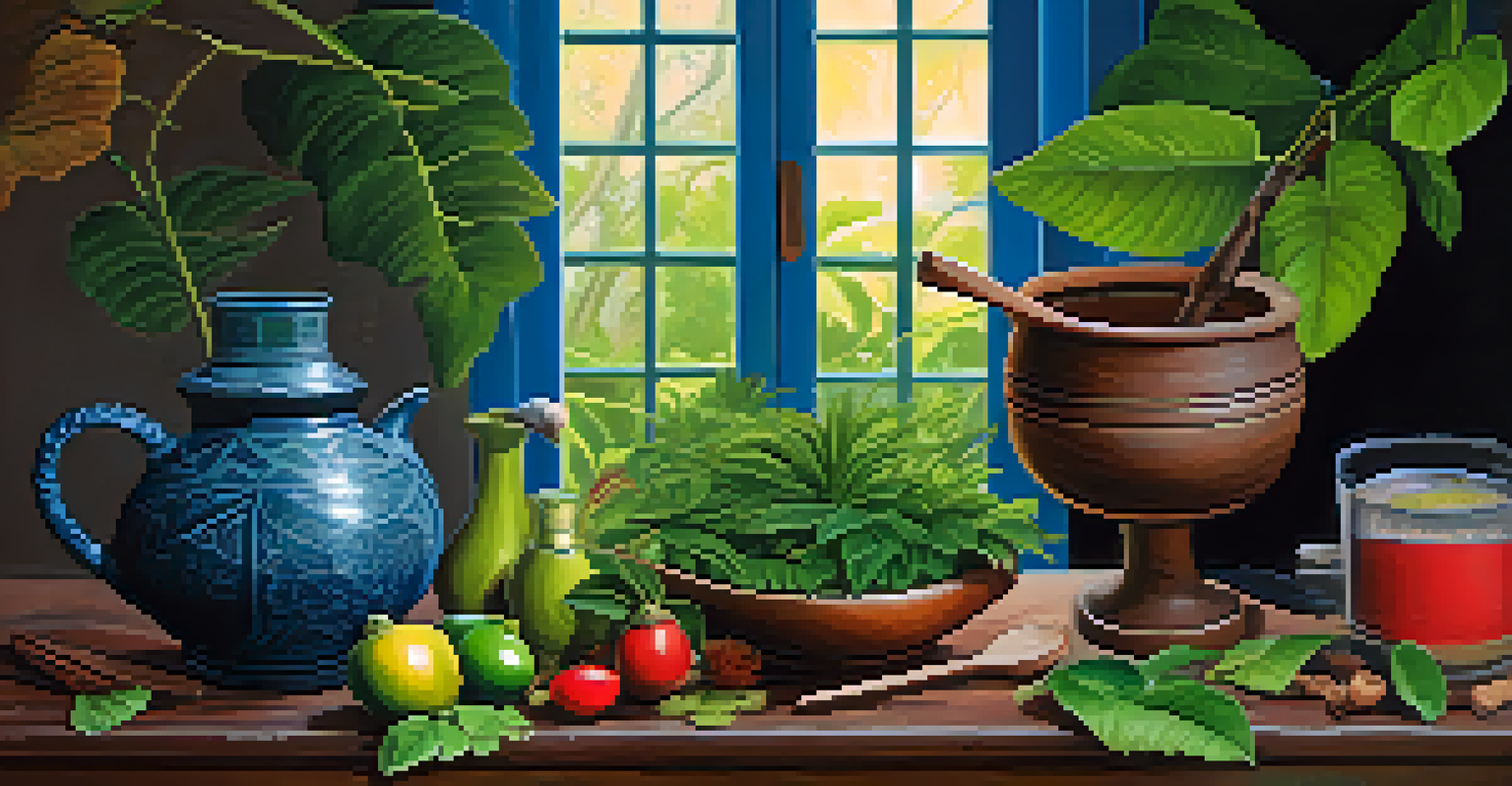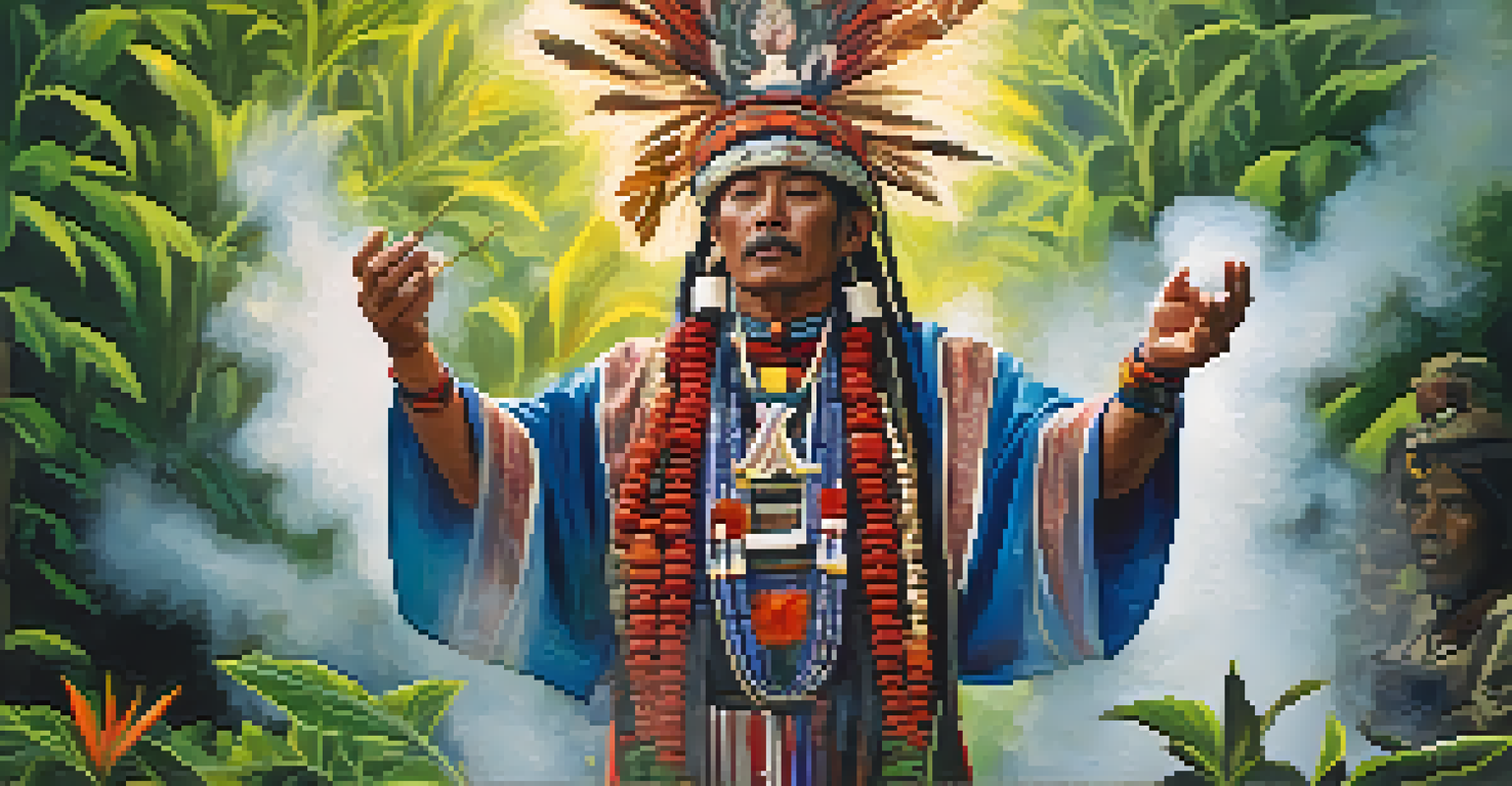Modern Techniques for Preparing Ayahuasca: A Comparative Study

Understanding Ayahuasca: A Brief Overview
Ayahuasca is a traditional spiritual brew made from the Banisteriopsis caapi vine and other plants. This ancient concoction, originating from Amazonian cultures, is known for its psychoactive properties. Its use dates back centuries, primarily for healing and religious ceremonies, but modern interest has surged in recent years, attracting both spiritual seekers and researchers alike.
Ayahuasca is a means of connecting to the divine and understanding oneself.
The primary active ingredient in Ayahuasca is DMT (dimethyltryptamine), which is responsible for its intense hallucinogenic effects. This substance, however, is not orally active unless combined with a monoamine oxidase inhibitor (MAOI), which is where the preparation of Ayahuasca becomes crucial. Understanding this combination is key to experiencing the brew's profound effects safely and effectively.
As we delve deeper, it's essential to appreciate the traditional methods of preparation that have been passed down through generations. These practices not only involve specific ingredients but also ritualistic elements that enhance the brew's potency and the participant's experience.
Traditional Ayahuasca Preparation Techniques
Traditional preparation of Ayahuasca involves a meticulous process, often carried out by experienced shamans. The vine and the leaves from other plants, such as Psychotria viridis, are typically used, and the preparation can take several days. This process usually includes boiling, mashing, and layering the ingredients, which allows the active compounds to infuse effectively.

During this preparation, shamans often chant or sing icaros—traditional songs that are believed to invoke the spirit of the plants and guide the experience. This aspect emphasizes the cultural significance of the brew, making it a deeply spiritual undertaking rather than just a chemical concoction. The connection to tradition is a vital part of the Ayahuasca experience.
Ayahuasca's Cultural Significance
The traditional use of Ayahuasca is deeply rooted in the spiritual and cultural practices of indigenous Amazonian communities.
Moreover, the use of specific plants can vary by region and tradition, adding a unique flavor and effect to each brew. This diversity in preparation techniques showcases the rich heritage and knowledge that has been preserved over time, providing a fascinating backdrop to the modern adaptations.
Modern Innovations in Ayahuasca Preparation
In recent years, modern techniques have emerged that streamline the preparation of Ayahuasca while still honoring its traditional roots. Innovations often involve the use of technology, such as pressure cookers, which can significantly reduce the time required to extract the active ingredients from the plant materials. This method allows for greater consistency in the potency of the brew.
The use of Ayahuasca has the potential to bridge the gap between traditional healing practices and modern therapeutic approaches.
Another modern approach includes the use of freeze-drying techniques, which preserve the active compounds while eliminating the need for prolonged boiling. This method appeals to those looking to produce Ayahuasca in a more controlled environment, making it easier to replicate the effects. However, it raises questions about the authenticity and spiritual connection traditionally associated with the preparation process.
Furthermore, there are now commercial entities offering Ayahuasca retreats that utilize these modern techniques, making the experience more accessible to a broader audience. While this democratization can enhance awareness of Ayahuasca, it also poses risks, as not all facilitators may prioritize safety or adhere to traditional practices.
Comparative Analysis: Traditional vs. Modern Methods
When comparing traditional and modern methods of Ayahuasca preparation, one key difference lies in the emphasis on ritual versus efficiency. Traditional methods prioritize the spiritual and communal aspects of preparation, with shamans guiding the process to ensure a sacred experience. In contrast, modern techniques often focus on maximizing efficiency and consistency, sometimes at the expense of the ritualistic elements.
While modern innovations can make Ayahuasca more accessible, they can also dilute the experience by removing the deeply ingrained cultural practices that have surrounded it for centuries. Participants in modern retreats may miss out on the sense of connection and reverence that comes from traditional preparation methods, which can significantly impact their experience.
Traditional vs. Modern Preparation
While traditional preparation emphasizes spiritual rituals, modern methods prioritize efficiency and accessibility.
However, both methods have their merits and can serve different audiences. Traditional preparation may appeal more to those seeking authenticity and cultural immersion, while modern methods attract those interested in a streamlined and possibly more scientific approach to the brew.
Safety Considerations in Ayahuasca Preparation
Safety is a critical concern when it comes to Ayahuasca preparation and consumption. Traditional shamans often have extensive knowledge of the plants and their effects, which plays a crucial role in ensuring a safe experience for participants. In contrast, modern methods may lack this depth of understanding, especially in commercial settings where profit could overshadow safety.
It's essential for individuals to conduct thorough research on the facilitators and the preparation methods being employed. Understanding the source of the ingredients and the experience of the person leading the ceremony can greatly impact safety and effectiveness. Participants should feel empowered to ask questions and seek transparency regarding the preparation process.
Moreover, individuals should also be aware of potential interactions between Ayahuasca and other substances, particularly certain medications. Consulting with healthcare professionals before participating in an Ayahuasca ceremony is a prudent step to ensure a safe and beneficial experience.
Cultural Implications of Modern Ayahuasca Practices
The rise of modern Ayahuasca practices has sparked a conversation about cultural appropriation and the ethical implications of using a sacred brew outside its traditional context. Many indigenous communities view Ayahuasca as a vital part of their cultural and spiritual identity, and commercialization can threaten this heritage. As more people seek Ayahuasca in non-traditional settings, the risk of commodifying a sacred practice increases.
It's crucial for modern practitioners and participants to approach Ayahuasca with respect and awareness of its cultural significance. Engaging with indigenous communities and honoring their knowledge can help bridge the gap between traditional and modern practices. This approach not only preserves the integrity of the brew but also fosters a deeper understanding of its roots.
Safety and Ethical Considerations
Ensuring safety in Ayahuasca practices requires thorough research on facilitators and a respectful approach to its cultural origins.
Additionally, discussions surrounding the ethical sourcing of ingredients and fair trade practices are becoming increasingly important. Ensuring that indigenous communities benefit from the commercialization of Ayahuasca is essential to maintaining respect for their traditions and livelihoods.
Future Directions in Ayahuasca Research and Preparation
As interest in Ayahuasca continues to grow, future research is likely to focus on both its psychological benefits and its cultural implications. Scientific studies are increasingly examining the therapeutic potential of Ayahuasca for treating conditions such as depression, anxiety, and PTSD. Such research may pave the way for more widespread acceptance and understanding of the brew in mainstream medicine.
Moreover, as modern preparation methods evolve, there may be opportunities to blend traditional knowledge with contemporary practices. This fusion could lead to new insights into the brew's effects and how best to prepare it for various therapeutic purposes. The key will be to maintain respect for the cultural heritage while exploring innovative techniques.

Ultimately, the future of Ayahuasca preparation and use will likely be shaped by a combination of tradition and modernity. The ongoing dialogue about safety, ethics, and cultural significance will be crucial as more people engage with this powerful brew, ensuring that its legacy is preserved for future generations.